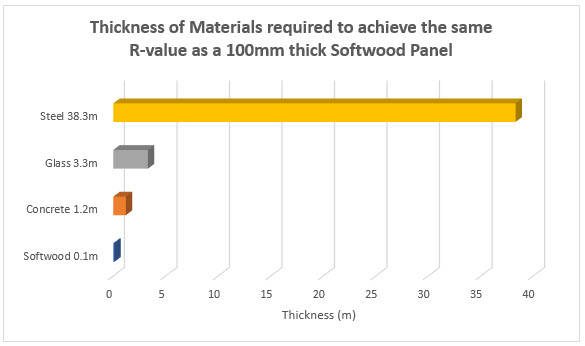Written by Tom Rickerby, Wesbeam Senior Structural Engineer.
U-value and R-value… What’s the difference?
The thermal performance of buildings is a hot topic in the construction industry. The changes that have occurred to the National Construction Code over several years have raised the profile of thermal performance, and building practitioners and designers are now carefully considering the material used to meet these requirements.
When discussing thermal performance requirements for building, you may have heard the terms “U-value” and “R-value”. But what are they, and how do they differ between different building materials?
A materials U-value refers to its’ Thermal Conductivity or Thermal Resistance. This is the rate that heat will conduct through one metre of a material. Materials that heat up quickly will have a high U-value. Think of putting a steel lid over a saucepan of boiling water. The steel will quickly heat and become painful to touch. This is because steel has a very high U-value. A material which heat flows through slowly, will have a low U-value.
A materials R-value on the other hand refers to the materials Insulation Value or Thermal Transmittance. This is equal to the inverse of the U-value.

A material with a higher R-value (and lower U-value) will have better insulation properties. For example, an insulation product with an ‘R4’ value will have better insulation properties than an ‘R2.5’ insulation product.
How does Timber compare to other Building Materials?
Timber is a natural insulating material. The organic, cellular structure of timber means that it has tiny air pockets inside the timber that act as a barrier for heat and cold. This means that both hardwood and softwood timber have useful insulation properties, especially when comparing to other building materials. Timber has a low U-value, and high R-value.
The chart below (data courtesy of Wood Solutions), illustrates the thickness of different materials that would be required to reach that same R-value as a 100mm panel of softwood timber.

For a concrete wall to have the same insulation performance as a 100mm thick softwood panel, it would need to be 1.2m thick. For aluminium (not shown on the graph… because it won’t fit), the solid wall would need to be 208m thick!
Benefits of Timber in Construction
The high R-value of timber helps reduce thermal bridges in buildings. This means that heat from one part of the building is less likely to transfer rapidly to another part of the building. Similarly, the heat stored in a building is less likely to be lost to the outside.
And because timber can be used efficiently in light-weight framing, such as stud walls, the gaps in the framing that are not present in materials such as brickwork or concrete, can be filled with high R-value insulation batts.
LEARN MORE ABOUT THE FEATURES OF LIGHT-WEIGHT TIMBER STRUCTURES
LEARN MORE ABOUT TIMBERS THERMAL PERFORMANCE